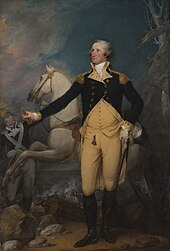John Trumbull
[6] On September 23, 1780, British agent Major John André was captured by Continental Army troops in North America; he was hanged as a spy on October 2, 1780.After news reached Great Britain, outrage flared and Trumbull was arrested for treason, since he was known to be an officer in the Continental Army and of similar rank to André.Arriving in late January 1782, he found employment with his brother David as a commissary agent for the army stationed at New Windsor, New York, during the winter of 1782 and 1783.His first major work, The Deputation from the Senate Presenting to Cincinnatus the Command of the Roman Armies, was accepted and displayed by the Royal Academy of Arts in that year.With assistance from Thomas Jefferson, who was then serving in Paris as the American minister to France, Trumbull began the early composition of the Declaration of Independence.While visiting with each signer or their family, Trumbull was always seeking funding and used the occasion to sell subscriptions to engravings that he produced from his paintings of the American Revolution.In 1794, Trumbull acted as secretary to John Jay in London during the negotiation of the treaty with Great Britain, which largely settled the boundary with Canada and began cotton export to the country.In 1796, he was appointed by the commissioners sent by the two countries as the fifth member of a commission charged with carrying out the seventh article of the Jay Treaty,[4] which mediated claims by American and British merchants and the opposing government stemming from actions that occurred during the war.





John Trumbull (disambiguation)Lebanon, ConnecticutNew York CityYale UniversityNew Haven, ConnecticutHarvard CollegePaintingDeclaration of Independencehistorical paintingsAmerican Revolutionary WarUnited States Capitol rotundaUnited States two-dollar billLebanonConnecticut ColonyJonathan Trumbullgovernor of ConnecticutPuritanJoseph TrumbullContinental ArmyRevolutionary WarJonathan Trumbull Jr.SpeakerHouse of RepresentativesBostonBritishAmericanBattle of Bunker Hillaide-de-camp to General George WashingtonHoratio GatesLondonBenjamin FranklinBenjamin Westminiature portraitsportrait of WashingtonJohn AndréNorth AmericaGreat BritaintreasonTothill Fields Bridewellarmy stationedNew Windsor, New YorkGilbert StuartBritainRoyal Academy of ArtsLucius Quinctius CincinnatusGeorge WashingtonYale University Art GallerySurrender of Lord CornwallisThomas JeffersonAmerican minister to FranceArthur MiddletonAmerican RevolutionItalianMaria CoswayAsher Brown DurandUnited States CongressRevolutionarySurrender of General BurgoyneGeneral George Washington Resigning His CommissionUnited States CapitolWashington, D.C.Death of General Warren at the Battle of Bunker's HillBoston Museum of Fine ArtsDeath of General Montgomery in the Attack on QuebecCapture of the Hessians at TrentonGeorge Washington at Trenton, New Jersey, on the night of January 2, 1777Death of General Mercer at the Battle of PrincetonWashington at Verplanck's PointMartha WashingtonCity of New YorkThe Sortie Made by the Garrison of Gibraltar, 1789Boston AthenaeumMetropolitan Museum of ArtGeneral George Washington at TrentonGeneral WashingtonGeorge ClintonNew York City HallRichard VarickAlexander Hamilton$10 billJohn JayAmerican Academy of Arts and SciencesAmerican Philosophical SocietyJohn AdamsRufus KingTimothy DwightStephen Van RensselaerCeracchi's bustCharleston, South CarolinaMrs. WashingtonNational Museum of American HistoryTreaty of New YorkJay TreatyXYZ AffairannuityneoclassicalOld CampusJames FrothinghamAmerican Academy of the Fine ArtsNational Academy of DesignU.S. two-dollar billStreet HallJohn Trumbull BirthplaceNational Historic Landmarkpostage stampHamiltonThe Death of General Warren at the Battle of Bunker's Hill, June 17, 1775The Death of General Montgomery in the Attack on Quebec, December 31, 1775The Capture of the Hessians at Trenton, December 26, 1776The Death of General Mercer at the Battle of Princeton, January 3, 1777The Surrender of General Burgoyne at SaratogaThe Surrender of Cornwallis at YorktownThe Sortie Made by the Garrison of GibraltarJosiah BartlettIsrael PutnamRichard Butler (general)Charles Cotesworth PinckneyGeorge WytheWayback Machinepublic domainChisholm, HughEncyclopædia BritannicaFordham UniversitySizer, TheodoreYale University PressFind a Grave